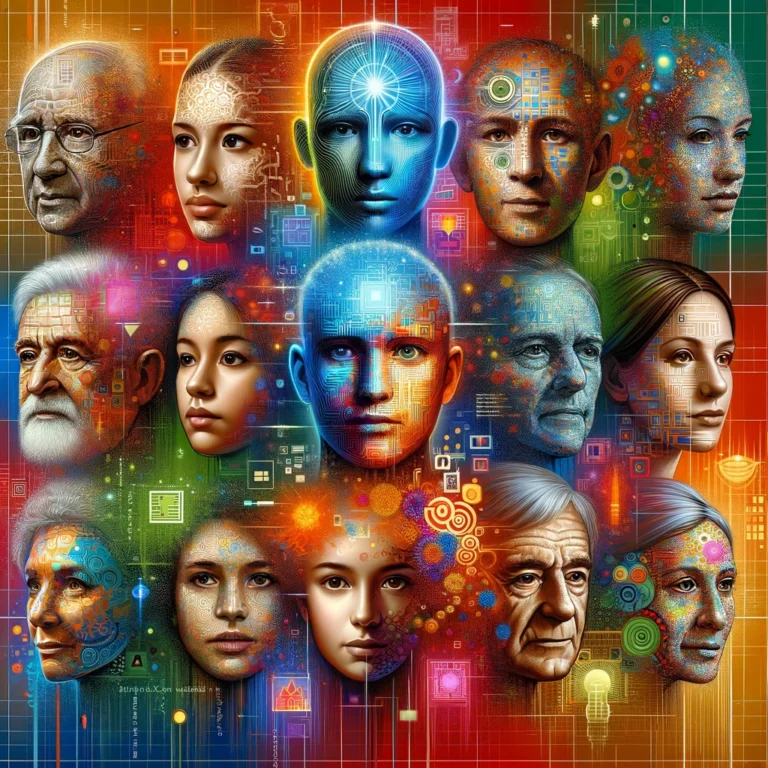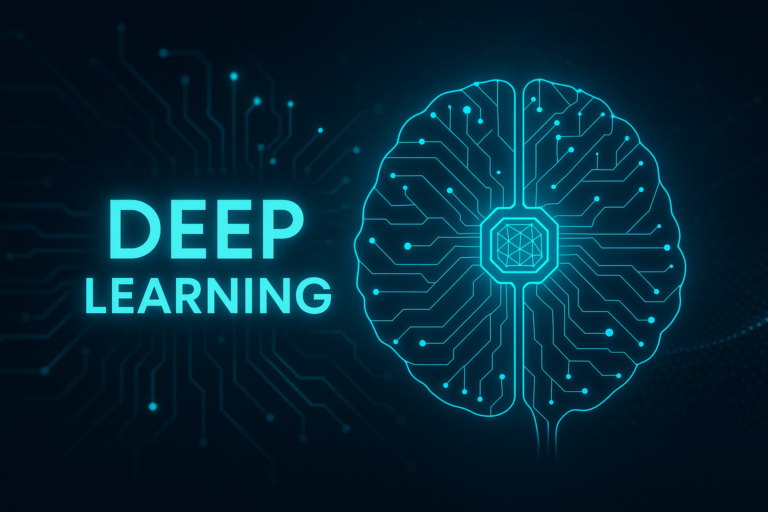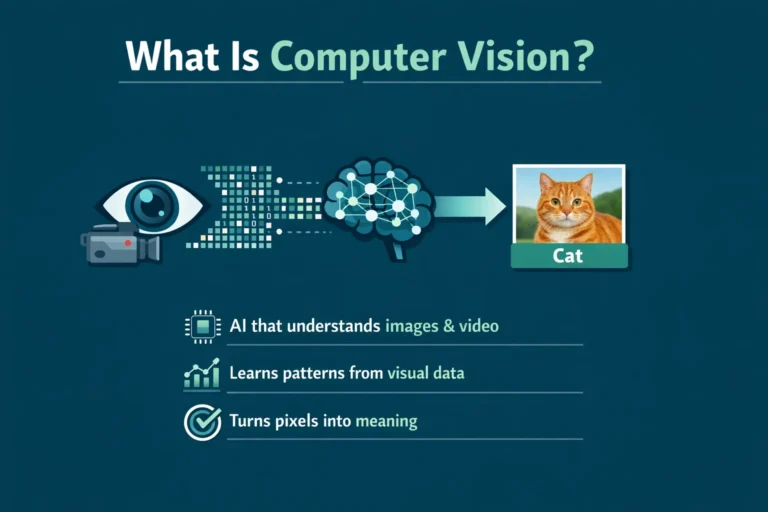AI in Retail: The Role of AI in Shaping the Future of Shopping
The integration of AI in retail marks a significant leap toward innovation and efficiency, heralding a new era in the way businesses interact with consumers, manage operations, and strategize for growth. This transformation, driven by AI’s capabilities, has not only enhanced customer experience but also revolutionized inventory management, sales, marketing, and fraud prevention, redefining the retail as a whole.
1. Transformative Impact of AI on Retail
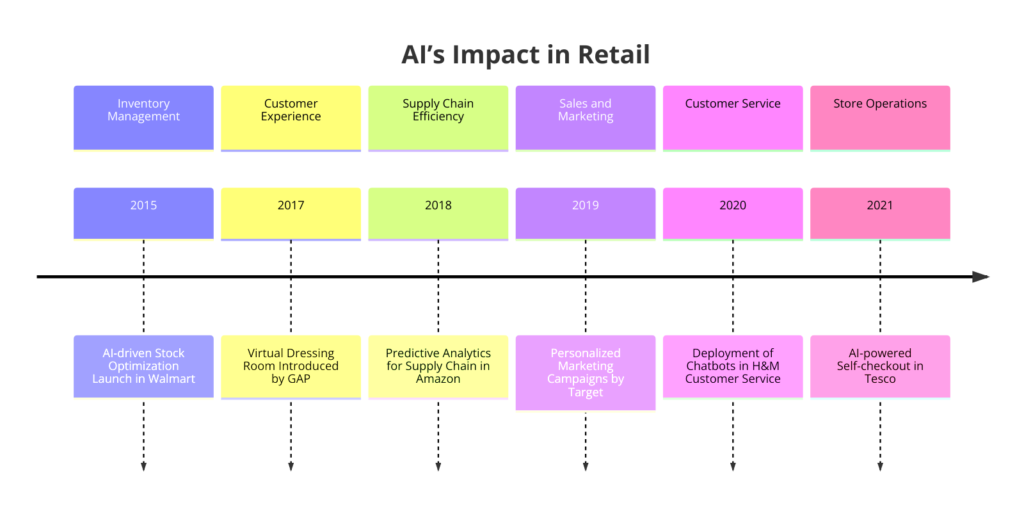
The transformative impact of AI in retail is multifaceted, influencing every corner of the industry:
- Customer Experience: AI has reimagined the way retailers engage with customers. Through personalized recommendations, virtual try-ons, and intelligent chatbots, AI technologies offer a customized shopping experience that aligns with individual preferences and needs.
- Operational Efficiency: AI-driven tools streamline operations, from inventory management to supply chain optimization. By leveraging predictive analytics, retailers can forecast demand, reduce overstock and stockouts, and ensure timely product delivery.
- Sales and Marketing: AI enriches sales strategies and marketing campaigns by analyzing consumer behavior and trends. This allows for targeted advertising, dynamic pricing, and personalized promotions that resonate with the customer base.
- Fraud Detection: The application of AI in monitoring transactions and detecting anomalies has significantly enhanced security measures in retail, reducing the incidence of fraud and protecting both the business and its customers.
Evolution of Retail through AI Technologies
The evolution of retail through AI technologies reflects a journey from traditional, manual processes to an automated, data-driven approach. Advances in AI, machine learning, and data analytics have facilitated this transition, enabling retailers to gain insights and make informed decisions with greater precision.
- From Reactive to Proactive: AI empowers retailers to move from a reactive stance to proactive strategies in managing inventory, engaging customers, and anticipating market trends. This shift is pivotal in staying competitive in a rapidly changing market.
- Enhanced Customer Insights: AI’s ability to process and analyze vast amounts of data has provided retailers with deep insights into customer behavior, preferences, and feedback, shaping the development of products and services.
- Integration with Emerging Technologies: AI’s evolution in retail is also characterized by its integration with other emerging technologies, such as the Internet of Things (IoT), augmented reality (AR), and robotics, which creates synergies that enhance efficiency and customer engagement.
The transformative journey of retail, powered by AI, is an ongoing narrative of innovation and adaptation.
As AI technologies continue to evolve, so will the retail industry, embracing new opportunities for growth, personalization, and efficiency.
This ongoing transformation promises to meet consumers’ ever-changing expectations and pave the way for a more resilient and dynamic retail ecosystem.
AI in Customer Experience Enhancement

In the retail sector, the advent of AI has significantly elevated the customer experience, offering personalization and convenience that were previously unattainable.
Personalization of Shopping Experiences
AI has transformed the shopping experience by making it highly personalized and customer-centric. Here’s how:
- AI-Driven Recommendations: Leveraging algorithms and machine learning, AI analyzes customer data, including past purchases, browsing history, and preferences, to suggest products that align with individual tastes. This simplifies the shopping process and enhances customer satisfaction by tailoring the experience to each user.
- Virtual Assistants and Chatbots: AI-powered virtual assistants and chatbots provide 24/7 customer service, answering queries, offering product recommendations, and assisting with transactions. These tools use natural language processing (NLP) to understand and respond to customer inquiries conversationally, improving engagement and support.
Examples of AI in Improving Customer Service and Engagement
The implementation of AI in enhancing customer service and engagement is evident across various platforms and technologies:
- Online Retailers: E-commerce giants like Amazon utilize AI to offer personalized shopping experiences. Their recommendation engines suggest products based on previous interactions, which not only increases the likelihood of purchases but also fosters customer loyalty.
- Brick-and-Mortar Stores: Physical retailers are also embracing AI to enhance in-store experiences. For example, bright fitting rooms equipped with AI technology suggest accessories or complementary items to the clothes a customer is trying on, merging digital convenience with the tactile advantage of traditional shopping.
- Customer Feedback Analysis: AI tools analyze customer feedback and social media mentions in real time, allowing retailers to swiftly address concerns and improve service. This proactive approach to customer engagement helps build trust and loyalty.
Impact on Customer Experience
The integration of AI in retail has markedly improved the customer experience by:
- Increasing Convenience: By automating routine inquiries and recommendations, AI allows customers to enjoy a seamless shopping experience, reducing friction and enhancing satisfaction.
- Building Personalized Relationships: AI’s ability to analyze and predict customer preferences helps retailers create a more personalized interaction, making customers feel valued and understood.
- Enhancing Decision-Making: With AI-driven insights and recommendations, customers can make informed decisions quickly, improving their shopping experience.
AI’s role in customer experience enhancement signifies a paradigm shift in retail, where personalization and efficiency are paramount.
As AI technologies evolve, so will the capabilities for engaging customers more meaningfully and innovatively.
The examples highlighted herein underscore the potential of AI to not only transform the shopping experience but also to redefine the standards of customer service and engagement in the retail industry.
2. AI in Inventory and Supply Chain Management
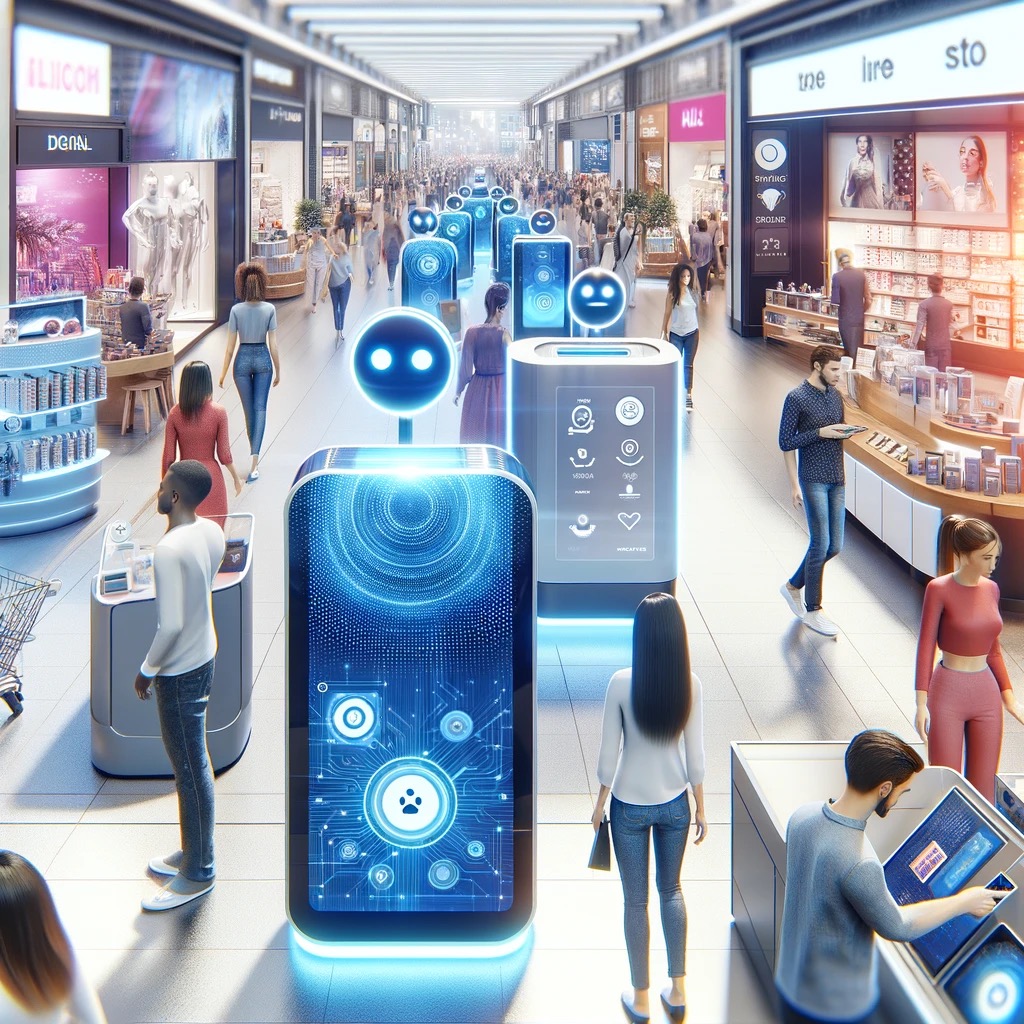
The application of AI in inventory and supply chain management represents a cornerstone of modern retail efficiency.
Through predictive analytics, AI provides unprecedented precision in forecasting, stock management, and supply chain optimization, significantly improving operational efficiency and customer satisfaction.
Use of AI for Predictive Analytics in Inventory Management
Predictive analytics, powered by AI, transforms inventory management by:
- Demand Forecasting: AI algorithms analyze historical sales data, market trends, and external factors like seasonality and economic indicators to predict future product demand accurately. This allows retailers to optimize stock levels, reducing both overstock and stockouts.
- Automated Replenishment: AI systems automate replenishment, ensuring efficient inventory levels. By analyzing sales velocity and forecasted demand, these systems can trigger reorder points for each product, streamlining inventory management.
- Enhanced Supplier Relations: Predictive analytics enable retailers to provide more accurate forecasts to suppliers, improving collaboration and lead times. This strengthens the supply chain and ensures that inventory is more aligned with demand.
Optimizing Supply Chains with AI
AI optimizes supply chain operations by:
- Route Optimization: AI tools analyze logistics and delivery routes in real-time, considering traffic, weather conditions, and delivery windows to optimize routes and reduce delivery times.
- Supplier Performance Analysis: By evaluating supplier reliability, quality, and lead times, AI helps retailers identify the best suppliers and manage risks in the supply chain.
- Real-Time Visibility: AI-driven systems offer real-time insights into the supply chain, from inventory levels to shipment tracking, enhancing transparency and enabling proactive management of potential disruptions.
Case Studies of AI-driven Efficiencies in Retail Operations
Several retailers have achieved notable efficiencies through the application of AI in inventory and supply chain management:
- Walmart’s Demand Forecasting: Walmart uses AI to analyze many variables to accurately forecast demand. This system allows for precise inventory management across its vast network, reducing waste and ensuring product availability.
- Zara’s Supply Chain Optimization: Zara employs AI and analytics to streamline its supply chain, from design to delivery. This approach enables rapid response to fashion trends and market demand, significantly reducing lead times and improving stock management.
- Amazon’s Supply Chain Automation: Amazon leverages AI for its supply chain operations, including predictive stocking in its fulfillment centers and optimizing delivery routes. This improves efficiency and enhances customer satisfaction through faster delivery times.
AI’s role in inventory and supply chain management is transformative. It offers retailers the tools to predict, plan, and respond with unprecedented accuracy and efficiency.
As AI technology advances, its potential to drive further innovations in retail operations remains vast.
These case studies exemplify AI’s tangible benefits to the retail sector, showcasing improved operational efficiencies, reduced costs, and enhanced customer experiences.
The future of retail lies in harnessing AI’s power to create more resilient, efficient, and customer-centric supply chains.
3. AI in Sales and Marketing
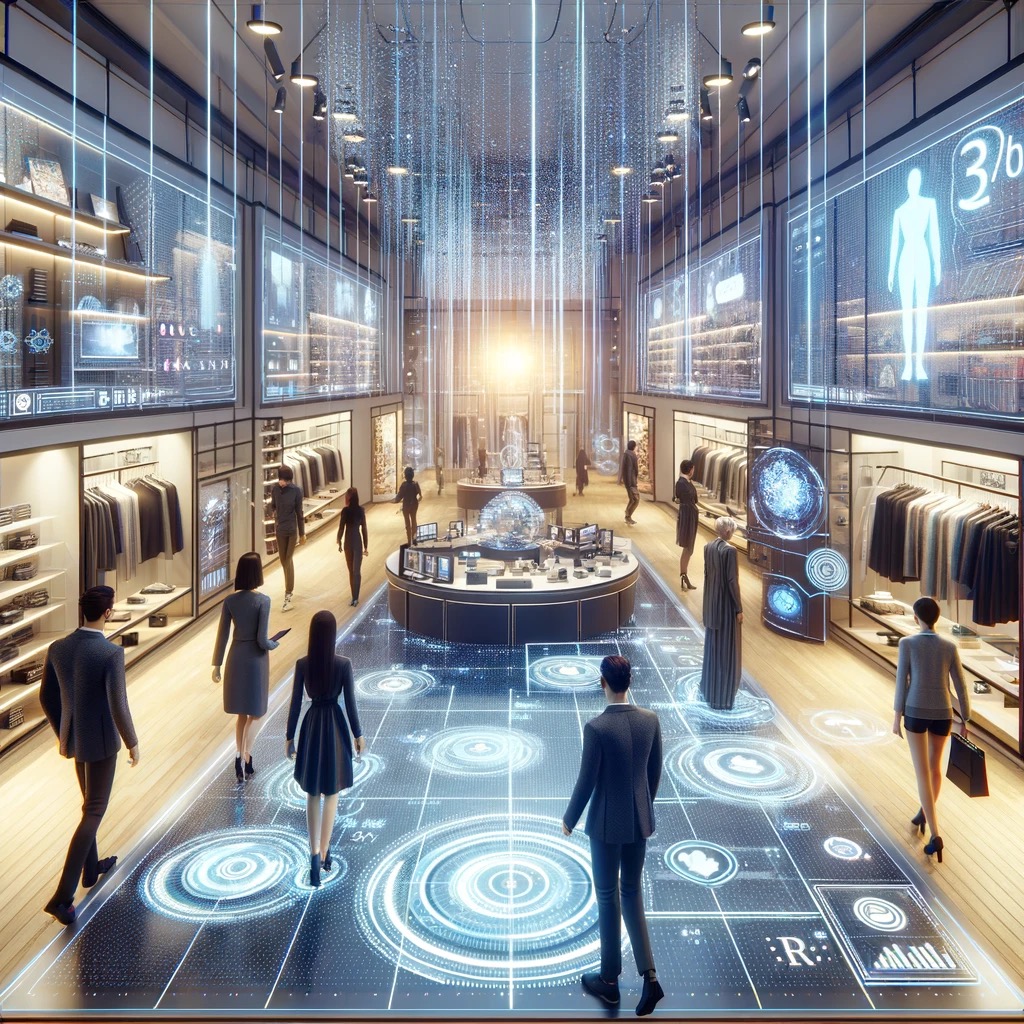
Artificial Intelligence (AI) has become an indispensable tool in retailers’ sales and marketing strategies, offering unprecedented capabilities in understanding consumer behavior, enhancing engagement, and optimizing sales processes.
Analyzing Consumer Behavior

AI excels in analyzing vast datasets to uncover insights into consumer behavior, preferences, and trends. This analysis is foundational in developing targeted marketing strategies that resonate with the audience. Here’s how AI contributes:
- Data-Driven Insights: Through machine learning algorithms, AI processes and interprets consumer data, from browsing patterns to purchase history, providing retailers with a deep understanding of their customer base.
- Customer Segmentation: AI enables the segmentation of customers into distinct groups based on their behavior and preferences, facilitating more focused and effective marketing efforts.
- Predictive Analytics: AI helps retailers anticipate needs and preferences by predicting future consumer behavior, allowing them to tailor marketing messages and product offerings proactively.
Tailoring Marketing Strategies
The insights gained from AI-driven analysis enable retailers to craft marketing strategies that are not only targeted but also highly personalized:
- Personalized Recommendations: AI algorithms generate customized product recommendations for individual customers, enhancing engagement and increasing the likelihood of purchases.
- Content Optimization: From email marketing to social media posts, AI tools optimize content delivery times, formats, and messages to maximize engagement and conversion rates.
- Campaign Effectiveness: AI models analyze the performance of marketing campaigns in real time, allowing for adjustments and optimizations to improve outcomes.
AI Applications in Dynamic Pricing and Sales Optimization
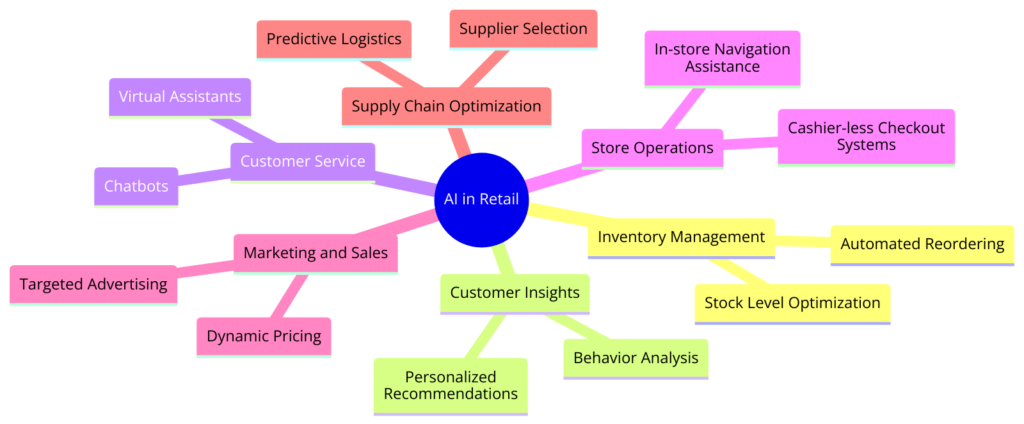
Dynamic pricing and sales optimization are areas where AI has made significant inroads, offering retailers tools to maximize profitability while meeting market demand:
- Dynamic Pricing: AI systems analyze market conditions, competitor pricing, and demand to adjust prices in real time, ensuring competitive pricing and maximizing profit margins.
- Inventory Management: AI optimizes sales by aligning inventory levels with predictive analytics on market demand, reducing overstock and stockouts.
- Sales Forecasting: AI’s predictive capabilities extend to sales forecasting, enabling retailers to more accurately plan for future demand, promotions, and stock levels.
Case Studies and Examples
Numerous retailers have successfully integrated AI into their sales and marketing strategies:
- Amazon’s Personalized Recommendations: Amazon’s recommendation engine, powered by AI, personalizes the shopping experience for millions of customers, driving sales and customer loyalty.
- Target’s Marketing Optimization: Target uses AI to analyze customer data and optimize marketing strategies, resulting in highly personalized promotions and offers.
- Uber’s Dynamic Pricing: Though not a traditional retailer, Uber’s use of AI for dynamic pricing illustrates the power of AI to adjust prices in real time based on demand and supply conditions, a strategy increasingly adopted by retail sectors.
AI’s role in sales and marketing represents a paradigm shift towards more personalized, efficient, and data-driven strategies.
By harnessing the power of AI, retailers can better understand and engage their customers and optimize pricing and sales for improved profitability.
As AI technology continues to evolve, its potential to further revolutionize sales and marketing strategies in the retail industry is immense, promising a future where retail experiences are increasingly customized, responsive, and efficient.
AI in Fraud Detection and Prevention
With its vast transaction volumes and digital interaction points, the retail industry is a prime target for fraudulent activities.
AI has emerged as a key player in enhancing transaction security and mitigating fraud risks. It employs sophisticated algorithms and data analysis techniques to identify and prevent fraudulent transactions in real-time.
Enhancing Security in Retail Transactions
AI enhances the security of retail transactions through several mechanisms:
- Real-Time Transaction Monitoring: AI systems continuously monitor transactions for suspicious patterns and anomalies that may indicate fraud. This real-time analysis enables immediate detection and response, significantly reducing the risk of fraud.
- Pattern Recognition: AI leverages machine learning to identify patterns and behaviors typical of fraudulent activities. By analyzing historical and real-time data, AI systems can accurately distinguish between legitimate and suspicious transactions.
- Risk Scoring: AI algorithms assign risk scores to transactions based on various factors, including transaction amount, frequency, and geographic location. Transactions with high-risk scores undergo further scrutiny or are automatically flagged for review.
Technologies and Methods for AI-driven Fraud Detection
Several technologies and methods underpin AI’s effectiveness in fraud detection:
- Machine Learning Models: Machine learning models are trained on vast datasets of transactional data to recognize the characteristics of fraudulent transactions. These models adapt over time, improving their accuracy in detecting fraud.
- Natural Language Processing (NLP): NLP analyzes customer communication and feedback for signs of fraud or phishing attempts. It can detect subtle cues in language that may indicate deceptive practices.
- Anomaly Detection Algorithms: These algorithms are specifically designed to identify outliers in data that deviate significantly from established patterns. Anomaly detection is crucial for spotting new and emerging fraud tactics.
Case Studies and Examples
- PayPal’s AI-driven Fraud Detection: PayPal uses AI to analyze each transaction across its platform in real-time, assessing risk and identifying potential fraud. This system has drastically reduced fraudulent transactions, saving millions of dollars.
- Shopify’s Fraud Analysis: Shopify offers its merchants an AI-powered fraud analysis tool. This tool analyzes orders for signs of fraud and provides recommendations on whether to proceed with the transaction. This tool helps small and medium-sized businesses protect themselves against fraud.
- Mastercard’s Decision Intelligence: Mastercard employs AI in its Decision Intelligence technology, which analyzes transaction data to identify fraud and improve the accuracy of real-time approvals, enhancing both security and customer experience.
Challenges and Future Directions
While AI significantly enhances fraud detection and prevention, it also faces challenges, including adapting to evolving fraud tactics and managing false positives.
Future developments in AI are expected to focus on improving the adaptability of AI systems to new fraud patterns, reducing false positives, and integrating AI with other technologies like blockchain for enhanced security.
AI’s role in fraud detection and prevention is transformative. It provides retailers and financial institutions with powerful tools to secure transactions and protect against fraud.
By leveraging machine learning, pattern recognition, and anomaly detection, AI systems offer a proactive and dynamic approach to fraud prevention.
As these technologies evolve, their importance in retail will only grow, marking a critical step towards safer and more secure retail transactions.
4. Challenges and Ethical Considerations
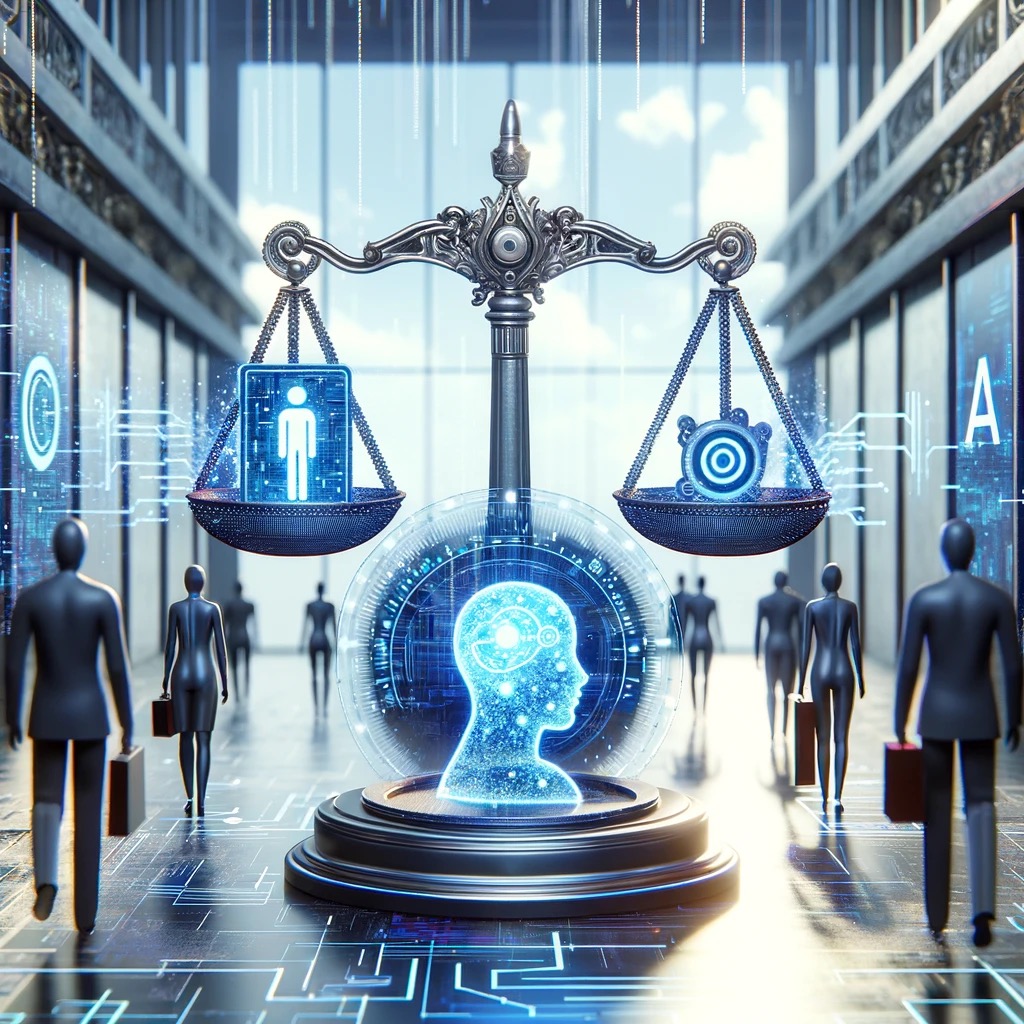
Integrating AI into retail brings opportunities for innovation and efficiency, significant challenges, and ethical considerations. These encompass data privacy, the ethical use of AI, its impact on employment, and the broader societal implications.
Data Privacy and Security
In an era where personalization is critical to customer engagement, retailers collect vast amounts of data, raising serious privacy concerns:
- Data Handling and Consent: Retailers must navigate the complex landscape of data privacy laws, ensuring that customer data is collected, stored, and used in compliance with regulations such as GDPR and CCPA. Ensuring transparency and securing informed consent are paramount.
- Data Security: With the increasing sophistication of cyber threats, protecting customer data against breaches is a critical challenge. Retailers must employ advanced security measures and constantly update them to guard against evolving threats.
Ethical AI Use
The ethical use of AI in retail involves several considerations, including bias, transparency, and accountability:
- Bias and Fairness: AI systems can inadvertently perpetuate bias if trained on skewed data sets. Retailers must ensure that AI algorithms are fair and unbiased, providing equal treatment to all customers.
- Transparency and Explainability: There’s a growing demand for AI systems to be transparent and explainable, mainly when used in decision-making processes that directly affect customers, such as credit scoring or personalized pricing.
Impact on Employment
AI’s impact on employment in the retail sector is a double-edged sword:
- Job Displacement: Automation and AI can lead to job displacement, especially in repetitive and task-specific roles. This raises concerns about the future of work and the need for workforce reskilling.
- New Job Creation: Conversely, AI also creates new job opportunities in areas such as AI system management, data analysis, and customer experience design. The challenge lies in ensuring the workforce has the necessary skills to transition into these new roles.
Balancing Innovation with Ethical Practices
To address these challenges, retailers must balance innovation with ethical practices:
- Developing Ethical Guidelines: Establishing clear ethical guidelines for AI use that prioritize customer welfare, data privacy, and transparency.
- Engaging in Responsible AI Development: Participating in or supporting initiatives that promote the development of responsible AI, including research into bias mitigation, security enhancements, and ethical AI frameworks.
- Fostering Dialogue and Collaboration: Encouraging dialogue among stakeholders, including policymakers, customers, and industry leaders, to collaboratively navigate the ethical implications of AI in retail.
The challenges and ethical considerations surrounding AI in retail necessitate a thoughtful approach to technology integration.
By prioritizing data privacy, ethical AI use, and the positive transformation of the workforce, retailers can effectively navigate these challenges.
Balancing AI innovation with ethical retail practices is essential for building trust, ensuring sustainability, and fostering a retail environment that benefits all stakeholders.
5. The Future of AI in Retail

As we look towards the future, AI’s role in retail is poised for even greater expansion and innovation.
Emerging trends and technological advancements promise further revolutionizing the retail experience for consumers and retailers.
Emerging Trends in AI Retail
- Augmented Reality (AR) and Virtual Reality (VR): AR and VR technologies are expected to integrate more seamlessly with AI to offer immersive shopping experiences. From virtual try-ons to interactive 3D product visualizations, these technologies will make online shopping more engaging and informative.
- Advanced Robotics: AI-equipped robots are becoming more sophisticated in physical stores and warehouses. They will handle tasks ranging from stocking shelves to guiding customers to products, improving efficiency and customer service.
- Personalized Omnichannel Experiences: AI will enable retailers to provide highly personalized shopping experiences across all channels, from online to in-store. AI can offer consistent and customized interactions by analyzing data from various touchpoints, enhancing brand loyalty.
- Sustainable and Ethical Retailing: AI will play a crucial role in promoting sustainability and ethical practices in retail. From optimizing supply chains for reduced environmental impact to ensuring fair labor practices through supply chain transparency, AI will help retailers meet growing consumer demand for responsibility and sustainability.
Predictions for AI in Retail
- AI-Driven Decision Making: AI will become an indispensable tool for decision-making at all retail levels, from inventory management to customer engagement strategies. Predictive analytics and machine learning models will provide insights that drive more informed, data-driven decisions.
- Increased Automation: Automation, powered by AI, will extend beyond routine tasks to more complex operations, including customer service and personalized marketing. This will free up human employees to focus on strategy and creativity.
- Enhanced Customer Privacy and Security: As AI technologies advance, so will mechanisms for protecting customer data and improving transaction security. AI will be at the forefront of detecting and responding to security threats, ensuring a safe shopping environment.
- Collaborative AI Systems: The future will see the rise of collaborative AI systems, where AI technologies work in concert with humans, leveraging each other’s strengths to enhance the retail experience. This collaboration will manifest in product design, customer service, and strategic planning.
The future of AI in retail is bright, marked by continuous innovation and transformative potential.
As AI technologies evolve, they will redefine the shopping experience and address broader challenges such as sustainability, ethical practices, and workforce development.
Retailers that embrace AI and integrate it thoughtfully into their operations will be well-positioned to lead in the competitive and ever-changing retail landscape.
6. Conclusion

Exploring AI’s impact on the retail industry reveals a landscape transformed by technological innovation.
From enhancing customer experiences with personalized shopping journeys to streamlining inventory and supply chain management, AI has proven to be a pivotal force in redefining retail operations.
Its role in sales and marketing strategies and its effectiveness in fraud detection and prevention showcases the broad spectrum of AI’s applicability and its potential to drive efficiency, security, and personalization.
Recap of AI’s Transformative Role in Retail
- Customer Experience Enhancement: AI has personalized the shopping experience, making it more engaging and responsive to individual preferences.
- Inventory and Supply Chain Optimization: AI has enabled more efficient inventory management and supply chain operations through predictive analytics, reducing costs and improving customer satisfaction.
- Sales and Marketing Innovation: AI’s consumer behavior analysis has allowed for more targeted and effective marketing strategies, optimizing sales and enhancing customer engagement.
- Fraud Detection and Security: AI’s advanced detection capabilities have significantly improved the security of retail transactions, protecting both retailers and customers.
- Challenges and Ethical Considerations: Integrating AI in retail also presents challenges, particularly regarding data privacy, employment impacts, and the ethical use of technology, highlighting the need for responsible innovation.
Encouraging Responsible and Innovative Use of AI
As we move forward, the continued integration of AI in the retail sector must be approached with a commitment to ethical practices and responsible innovation.
Retailers must navigate the challenges associated with AI, including data privacy concerns and the displacement of traditional jobs, with transparency and a focus on creating value for all stakeholders.
- Ethical AI Use: Retailers should follow ethical guidelines for AI use and ensure that AI-driven solutions are fair, transparent, and respectful of privacy.
- Reskilling the Workforce: As AI transforms retail jobs, there is a critical need to invest in training and reskilling programs to prepare employees for new roles in the AI-driven retail environment.
- Sustainable and Inclusive Growth: The future of retail should leverage AI to promote sustainability, inclusivity, and equitable growth. This will ensure that the benefits of AI are widely distributed and contribute to a better society.
Future Directions
The journey of AI in retail is ongoing, with future advancements expected to enhance further the shopping experience, operational efficiency, and strategic decision-making.
Retailers that embrace AI while prioritizing ethical considerations and sustainability will lead the way in creating an innovative, customer-centric, and resilient retail landscape.
Final Thoughts
AI is a beacon of innovation in the retail sector, offering challenges and opportunities.
By embracing AI responsibly and creatively, retailers can ensure a future where technology enhances every aspect of the retail experience, from the supply chain to the customer’s hands.
Balancing innovation with ethical considerations is the key to unlocking AI’s full potential, ensuring a retail ecosystem that benefits everyone involved.
FAQ & Answers
1. How is AI used in the retail industry?
AI is utilized in personalizing customer experiences, optimizing inventory and supply chain management, enhancing sales and marketing strategies, and improving security through fraud detection.
2. What are the challenges of implementing AI in retail?
Challenges include ensuring customer data privacy, navigating the ethical use of AI, and mitigating potential impacts on employment within the retail sector.
Quizzes
Quiz 1: “AI in Retail” – Match AI technologies to their applications in retail scenarios.
Match each AI technology to its correct application in the following retail scenarios:
AI Technologies: A. Machine Learning Algorithms B. Chatbots and Virtual Assistants C. Computer Vision D. Recommendation Engines E. Predictive Analytics
Retail Applications:
- Personalizing the online shopping experience by suggesting products based on browsing history and purchase behavior.
- Analyzing customer feedback and inquiries in real-time to provide immediate support and assistance.
- Enhancing inventory management and demand forecasting to optimize stock levels and reduce waste.
- Automating the checkout process in physical stores, allowing customers to skip traditional checkout lines.
- Generating insights from sales data to predict future shopping trends and consumer preferences.
Match each AI technology (A-E) with its corresponding retail application (1-5).
Here are the matches between the AI technologies and their applications in retail scenarios:
A. Machine Learning Algorithms – 3. Enhancing inventory management and demand forecasting to optimize stock levels and reduce waste.
Machine learning algorithms analyze historical sales data and other factors to improve inventory accuracy and predict future demand, helping retailers manage their stock more efficiently.
B. Chatbots and Virtual Assistants – 2. Analyzing customer feedback and inquiries in real-time to provide immediate support and assistance.
Chatbots and virtual assistants use natural language processing to interact with customers, offering quick responses to queries and enhancing the customer service experience.
C. Computer Vision – 4. Automating the checkout process in physical stores, allowing customers to skip traditional checkout lines.
Computer vision technology enables automated checkout systems that recognize products and process payments without the need for manual scanning, streamlining the shopping experience.
D. Recommendation Engines – 1. Personalizing the online shopping experience by suggesting products based on browsing history and purchase behavior.
Recommendation engines use customer data to suggest products that align with their preferences and previous interactions, enhancing personalization and engagement in online retail.
E. Predictive Analytics – 5. Generating insights from sales data to predict future shopping trends and consumer preferences.
Predictive analytics tools analyze vast amounts of sales and customer data to identify patterns and predict future trends, helping retailers make informed decisions about product offerings and marketing strategies.
These matches illustrate how AI technologies are leveraged in the retail sector to improve operations, enhance customer experiences, and drive sales through personalized engagement and efficient inventory management.
Quiz 2: “Retail Innovations” – A quiz on recent AI breakthroughs in the retail industry.
Explore the recent AI breakthroughs in the retail industry. For each innovation described below, try to identify the specific application or the type of AI technology being discussed:
- Virtual Try-On Solutions: This innovation allows customers to see how clothes, accessories, or even makeup would look on them using their smartphone or computer camera. It employs advanced AI algorithms to provide a realistic and personalized shopping experience online.
- Smart Shelf Technology: Retail stores implement shelves equipped with weight sensors and AI to automatically monitor stock levels in real-time. This system alerts staff when items are running low or when a restock is needed, improving inventory management.
- Voice-Activated Shopping: Customers use voice commands to search for products, add items to their shopping cart, and make purchases through an online retailer’s platform. This AI-powered technology understands and processes natural language to facilitate hands-free shopping.
- AI-Driven Fraud Detection: To combat online transaction fraud, retailers use AI systems that analyze buying patterns and flag unusual activities. This helps in identifying potentially fraudulent transactions before they are processed, enhancing security for both retailers and consumers.
- Customer Sentiment Analysis: Retailers employ AI to analyze customer reviews, social media posts, and feedback surveys to gauge overall sentiment about their products and services. This insight helps brands to improve their offerings and address customer concerns more effectively.
Identify the specific AI innovation or technology used in these recent retail applications.
Here are the specific AI innovations or technologies being described in the recent retail applications:
- Virtual Try-On Solutions: This innovation is powered by AI and Augmented Reality (AR) technologies. These solutions use AI to analyze the user’s dimensions and preferences, combined with AR to superimpose clothing or makeup on the user’s image in real-time, offering a personalized and immersive shopping experience online.
- Smart Shelf Technology: The technology behind this is AI with IoT (Internet of Things) integration. Smart shelves equipped with weight sensors and connected to an AI system can monitor stock levels, automatically detecting when products are low and need restocking, thereby optimizing inventory management.
- Voice-Activated Shopping: This application uses Natural Language Processing (NLP), a subset of AI, to enable voice-activated shopping. NLP allows the system to understand and process human language, enabling customers to interact with online shopping platforms using voice commands, making the shopping experience more convenient.
- AI-Driven Fraud Detection: This is facilitated by Machine Learning Algorithms for Fraud Detection. These algorithms analyze patterns in transaction data to identify and flag activities that deviate from the norm, helping to prevent fraud in online retail transactions.
- Customer Sentiment Analysis: The technology used here is AI for Sentiment Analysis. By analyzing text from customer reviews, social media, and feedback surveys, AI algorithms assess the sentiment towards products or services, providing retailers with valuable insights into customer satisfaction and areas for improvement.
Each of these AI breakthroughs showcases how artificial intelligence can enhance the retail experience, from improving the online shopping experience with virtual try-ons and voice shopping to optimizing inventory management, enhancing security, and understanding customer sentiment.


